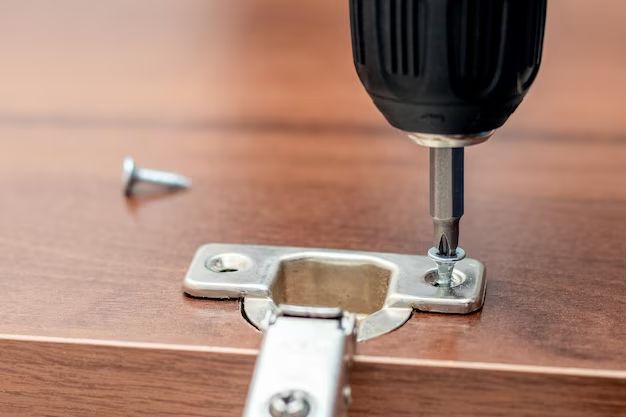When it comes time to remove door hinges, having the right tool for the job will make the process much easier. Choosing the wrong tool can lead to damaged hinges, screws, and door frames. This article will examine the most common tools used for cutting door hinges and provide recommendations on which ones are best suited for different hinge types and situations.
Page Contents
Manual Hinge Cutters
Manual hinge cutters, also known as hinge shears or nibblers, are handy specialized tools designed specifically for cutting through door hinges. They typically resemble a pair of scissors with heavy-duty sharp blades capable of slicing through metal. Here are some of the most popular manual hinge cutter options:
| Tool | Description |
|---|---|
| Bolt cutters | Bolt cutters have short, powerful blades perfect for chomping through hinge pins. The short jaws allow you to snip pins even in tight spaces. |
| Hinge cutter pliers | These pliers have angled cutting jaws designed to get into the tight space around hinges. The sharper blades shear through hinge barrels with ease. |
| Hinge shear nibblers | Nibblers have long, sharp blades that can slice through thick hinge barrels. The long reach allows you to cut the full length of the hinge in one squeeze. |
Manual hinge cutters are quick and easy to use. They provide good control and precision. The main downsides are that they require some physical effort to operate and are really only practical for cutting one hinge at a time. But for occasional hinge removal jobs, they get the job done with minimal investment.
When to Use Manual Hinge Cutters
Manual hinge cutters work best when:
- You only need to remove a few hinges
- The hinges are easily accessible
- You need precision and control over the cuts
- You don’t want to invest in power tools
Power Tools for Cutting Hinges
For removing numerous hinges or hinges in difficult to reach areas, power tools make the job much faster and easier. Here are some powered cutting tools up to the hinge removal task:
| Tool | Description |
|---|---|
| Angle grinder | The abrasive metal cut-off discs used with angle grinders slice through hinge pins and barrels with ease. Great for hard-to-reach hinges. |
| Oscillating multi-tool | The oscillating blades of these tools can rapidly cut through hinge barrels. Their small size allows cutting even in tight spaces. |
| Circular saw | Fitted with a metal-cutting blade, a circular saw makes swift work of hinge barrels. Best for quickly removing multiple hinges. |
| Reciprocating saw | The back and forth motion of reciprocating saws let them tear through hinges with minimal effort. Great for hard-to-access hinge barrels. |
Power tools greatly reduce the physical exertion required to cut hinges. They also allow you to take on many hinges at once. However, they lack the precision of manual tools and can be prone to damage surrounding areas if not used carefully.
When to Use Power Tools for Cutting Hinges
Power cutting tools excel when:
- You need to remove many hinges
- The hinges are in awkward, hard-to-reach spots
- Time-savings is important
- You possess experience using power tools
Factors to Consider When Choosing Hinge Cutting Tools
With both manual and power cutting tools viable options, which is the right choice for your particular hinge removal job? Here are some key factors to help determine the best tool for the task:
Hinge Location
Consider where the hinge is located and how easy it is to access. For hinges in cramped areas like between a door and jamb, manual tools and oscillating multi-tools are often the only options that fit.
Number of Hinges
For removing multiple hinges, the speed of power tools gives them a clear advantage. Manual cutters make more sense for quick one-off hinge removal jobs.
Hinge Material
Knowing the hinge material helps choose a tool that can cut through it. Softer bronze and brass hinges can be removed with basic tools. Harder steel hinges require more powerful cutting tools.
Condition of Hinges
Tight, clean hinges require the most cutting force. Corroded or slightly bent hinges come off easier. Match the tool capabilities accordingly.
Skill Level
Factor in experience using cutting tools. Someone new to power tools is often better off starting with manual hinge cutters to avoid accidents.
Damage Concerns
Precision cutting is needed around delicate decorative trim or when wanting to preserve the hinge. In these cases, careful work with manual cutters is best.
Recommendations for Common Hinge Types
Keeping these deciding factors in mind, here are some ideal tool choices for some of the most prevalent hinge types:
| Hinge Type | Best Cutting Tool |
|---|---|
| Small diameter brass butt hinges | Hinge cutting pliers or oscillating multi-tool |
| Large diameter bronze butt hinges | Hinge shear nibblers or angle grinder |
| Wrought iron hinges | Angle grinder with cut-off wheel |
| Continuous (piano) hinges | Hacksaw or reciprocating saw |
| Embedded/mortised door hinges | Oscillating multi-tool |
Conclusion
Removing old door hinges is made much simpler when using the proper cutting tool. Manual hinge cutters provide precision and control for occasional hinge removal. Power tools like angle grinders, oscillating multi-tools, circular saws and reciprocating saws make fast work of batches of hinges. Matching the correct cutting tool to factors like hinge location, number of hinges, material and accessibility results in smooth, fast hinge removal without damage.
